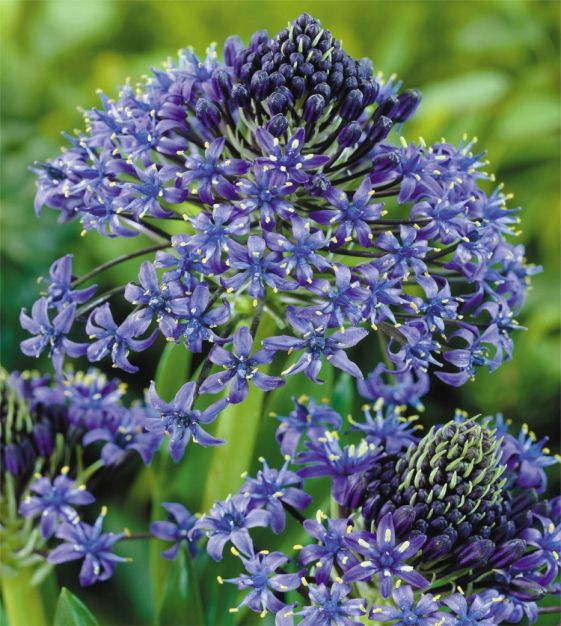-
- 20%-Off Website Specials
- New for 2024!
- Tulips
- Narcissi
- Allium
- Anemone blanda
- Brodiaea
- Camassia
- Chionodoxa
- Corydalis
- Crocus
- Eranthis
- Eremurus
- Erythronium
- Fritillaria
- Galanthus
- Geranium
- Gladiolus
- Hyacinths
- Hyacinthoides
- Ipheion uniflorum
- Dutch Iris
- Rock Garden Iris
- Ixiolirion
- Leucojum Aestivum
- Muscari
- Ornithogalum
- Oxalis
- Puschkinia
- Scilla
- Lilies
- Peonies
- Tender Bulbs
- Anemone Giants
- Tecolote Ranunculus
- Freesias
- Paperwhites
- Amaryllis
Scilla peruviana
Native to 17th century Spain, the tender Giant Squill has one, or more, stems of 6" globes composed of compact, lavender-blue florets with strappy, 12" foliage.
In HZ 8-10, plant each bulb shallowly, 8" to 10" apart, with the bulb nose covered by 1" to 2" of soil in full to partial sunlight and well-draining, lean soil. A low rosette of fall foliage may appear. Water regularly in spring, but discontinue watering after the flowers and foliage fade into summer dormancy.
In colder zones, it’s best planted shallowly with its nose peeking out of the soil surface in containers with sterile, neutral pH soil in well-draining pots. Fertilize lightly. Allow the bulbs to go dormant in mid-summer, after flowers and foliage fade. The plants will begin growing again in late summer or early fall. Take containers indoors before frost and bring them back outdoors after the last spring frost. Bulb size: 18 cm/up. HZ: 8-10. Height: 6" to 12".
Scilla peruviana Horticultural Tips
In HZ 8-10, plant each bulb shallowly, 8" to 10" apart, with the bulb nose covered by 1" to 2" of soil in full to partial sunlight and well-draining, lean soil. A low rosette of fall foliage may appear. Water regularly in spring, but discontinue watering after the flowers and foliage fade into summer dormancy.
In colder zones, it’s best planted shallowly with its nose peeking out of the soil surface in containers with sterile, neutral pH soil in well-draining pots. Fertilize lightly. Allow the bulbs to go dormant in mid-summer, after flowers and foliage fade. The plants will begin growing again in late summer or early fall. Take containers indoors before frost and bring them back outdoors after the last spring frost. Bulb size: 18 cm/up. HZ: 8-10. Height: 6" to 12".
Scilla peruviana Horticultural Tips
- Information
Scilla peruviana
Native to 17th century Spain, the tender Giant Squill has one, or more, stems of 6" globes composed of compact, lavender-blue florets with strappy, 12" foliage.
In HZ 8-10, plant each bulb shallowly, 8" to 10" apart, with the bulb nose covered by 2" of soil in full to partial sunlight and well-draining, lean soil. A low rosette of fall foliage may appear. Water regularly in spring, but discontinue watering after the flowers and foliage fade into summer dormancy.
In colder zones, it’s best planted shallowly with its nose peeking out of the soil surface in containers with sterile, neutral pH soil in well-draining pots. Fertilize lightly. Allow the bulbs to go dormant in mid-summer, after flowers and foliage fade. The plants will begin growing again in late summer or early fall. Take containers indoors before frost and bring them back outdoors after the last spring frost. Bulb size: 18 cm/up. HZ: 8-10. 6" to 12".
Native to 17th century Spain, the tender Giant Squill has one, or more, stems of 6" globes composed of compact, lavender-blue florets with strappy, 12" foliage.
In HZ 8-10, plant each bulb shallowly, 8" to 10" apart, with the bulb nose covered by 2" of soil in full to partial sunlight and well-draining, lean soil. A low rosette of fall foliage may appear. Water regularly in spring, but discontinue watering after the flowers and foliage fade into summer dormancy.
In colder zones, it’s best planted shallowly with its nose peeking out of the soil surface in containers with sterile, neutral pH soil in well-draining pots. Fertilize lightly. Allow the bulbs to go dormant in mid-summer, after flowers and foliage fade. The plants will begin growing again in late summer or early fall. Take containers indoors before frost and bring them back outdoors after the last spring frost. Bulb size: 18 cm/up. HZ: 8-10. 6" to 12".
Scilla peruviana
Native to 17th century Spain, the tender Giant Squill has one, or more, stems of 6" globes composed of compact, lavender-blue florets with strappy, 12" foliage.
In HZ 8-10, plant each bulb shallowly, 8" to 10" apart, with the bulb nose covered by 2" of soil in full to partial sunlight and well-draining, lean soil. A low rosette of fall foliage may appear. Water regularly in spring, but discontinue watering after the flowers and foliage fade into summer dormancy.
In colder zones, it’s best planted shallowly with its nose peeking out of the soil surface in containers with sterile, neutral pH soil in well-draining pots. Fertilize lightly. Allow the bulbs to go dormant in mid-summer, after flowers and foliage fade. The plants will begin growing again in late summer or early fall. Take containers indoors before frost and bring them back outdoors after the last spring frost. Bulb size: 18 cm/up. HZ: 8-10. 6" to 12".
Native to 17th century Spain, the tender Giant Squill has one, or more, stems of 6" globes composed of compact, lavender-blue florets with strappy, 12" foliage.
In HZ 8-10, plant each bulb shallowly, 8" to 10" apart, with the bulb nose covered by 2" of soil in full to partial sunlight and well-draining, lean soil. A low rosette of fall foliage may appear. Water regularly in spring, but discontinue watering after the flowers and foliage fade into summer dormancy.
In colder zones, it’s best planted shallowly with its nose peeking out of the soil surface in containers with sterile, neutral pH soil in well-draining pots. Fertilize lightly. Allow the bulbs to go dormant in mid-summer, after flowers and foliage fade. The plants will begin growing again in late summer or early fall. Take containers indoors before frost and bring them back outdoors after the last spring frost. Bulb size: 18 cm/up. HZ: 8-10. 6" to 12".





